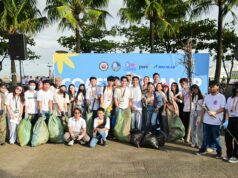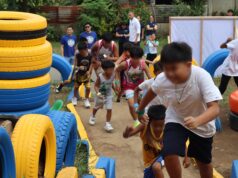SAN ISIDRO, Nueva Ecija — Mary Ann Pantaleon, 21, has passed the examination for teachers in her first try.
But instead of taking the traditional job of teaching regular classes, she opted to provide education to out-of-school youths and adults who failed to attend school during their younger days in San Isidro, Nueva Ecija.
Pantaleon said she and her companions, numbering about 100, have banded together to visit every corner of this town’s nine villages since the summer of 2009 after learning for themselves that many children, including those attending schools, dramatically need to improve in reading.
“That was when we worked under the DOLE’s (Department of Labor and Employment’s) summer job program,” Pantaleon said. For that summer, she related, the public employment service office (PESO) of San Isidro tasked them to conduct a survey on the literacy and economics of the San Isidro residents.
Such findings, inspired the group to create the Bayan Aasenso Sa Abot-Kaya (Basa) project, which aimed at providing an alternative avenue for learning to children. Pantaleon said that upon submission of their findings to the PESO and the municipal government, their group pooled resources to implement “what we believe can help uplift literacy in our own little ways.”
Mayor Sonia Lorenzo finds the youth group’s activity as an “exercise of real people power.”
“Mula sa kanilang survey ay naisip nilang magsama-sama para i-solve ang nakita nilang problema,” said Lorenzo. “That is participative governance,” she said. Participative governance, Lorenzo said, is the system of government where projects and program address the people’s concerns because “the programs actually come from them.”
The project, through the eventual collaboration of the local government, has tapped the cooperation of other institutions such as Ateneo University.
Pantaleon said that besides enhancing the children’s interest in reading, they were being taught values. “Mga kuwento na nagtataglay ng kabutihang asal na karaniwang napapabayaan na ang kalimitang binabasa namin sa kanila,” she stressed.
Also, the project has taken the children from the dangerous life outside their houses. “Natutuwa kami na bumaba ang bilang nga mga kabataang hindi marunong bumasa at mga naaksidente sa lansangan, maging yung nakakagat ng aso,” she said.
But instead of taking the traditional job of teaching regular classes, she opted to provide education to out-of-school youths and adults who failed to attend school during their younger days in San Isidro, Nueva Ecija.
Pantaleon said she and her companions, numbering about 100, have banded together to visit every corner of this town’s nine villages since the summer of 2009 after learning for themselves that many children, including those attending schools, dramatically need to improve in reading.
“That was when we worked under the DOLE’s (Department of Labor and Employment’s) summer job program,” Pantaleon said. For that summer, she related, the public employment service office (PESO) of San Isidro tasked them to conduct a survey on the literacy and economics of the San Isidro residents.
Such findings, inspired the group to create the Bayan Aasenso Sa Abot-Kaya (Basa) project, which aimed at providing an alternative avenue for learning to children. Pantaleon said that upon submission of their findings to the PESO and the municipal government, their group pooled resources to implement “what we believe can help uplift literacy in our own little ways.”
Mayor Sonia Lorenzo finds the youth group’s activity as an “exercise of real people power.”
“Mula sa kanilang survey ay naisip nilang magsama-sama para i-solve ang nakita nilang problema,” said Lorenzo. “That is participative governance,” she said. Participative governance, Lorenzo said, is the system of government where projects and program address the people’s concerns because “the programs actually come from them.”
The project, through the eventual collaboration of the local government, has tapped the cooperation of other institutions such as Ateneo University.
Pantaleon said that besides enhancing the children’s interest in reading, they were being taught values. “Mga kuwento na nagtataglay ng kabutihang asal na karaniwang napapabayaan na ang kalimitang binabasa namin sa kanila,” she stressed.
Also, the project has taken the children from the dangerous life outside their houses. “Natutuwa kami na bumaba ang bilang nga mga kabataang hindi marunong bumasa at mga naaksidente sa lansangan, maging yung nakakagat ng aso,” she said.




